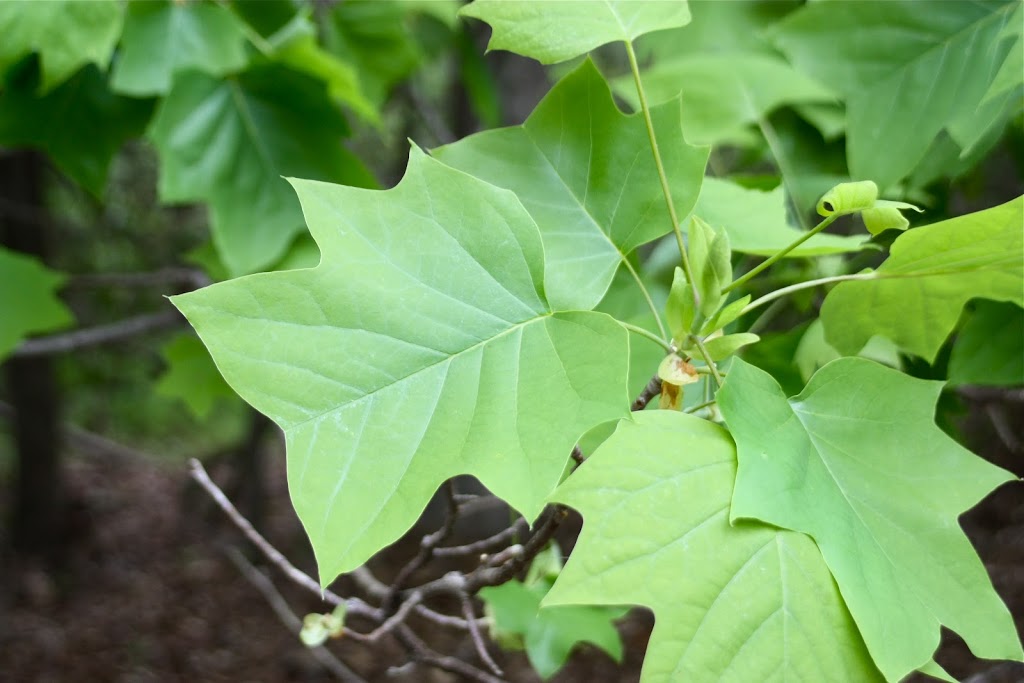Tulip Tree
Liriodendron tulipifera L.
Description
Tulip tree, also known as yellow poplar and tulip poplar, is a fast-growing eudicot with a long, straight trunk1,2. It is commonly referred to as the tulip poplar or yellow poplar because of its pale to golden yellow flowers that resemble tulips³. These flowers are nearly two inches long, have orange at the base, are aromatic, and can be up to 50 feet off the ground4. The tree has simple leaves with an alternate arrangement on the branch5. Leaves are pinnately veined, 3-6 inches long, distinctive lobes, a flat base, and two triangular tips4,6. The leaves grow on the tree in an oval pattern when the tree is mature7. This species blooms in mid spring². The fruit has winged seeds, is brown and cone-shaped and can be harvested in the fall8. The tulip tree prefers full sun, has low drought tolerance, and is mostly planted for ornamental purposes. The tree thrives in a slightly acidic soil, pH range of 4.5 to 7.55. In typical conditions, this species is one of the tallest trees in the deciduous forest can grow up to 200 feet tall with a trunk diameter of 12 feet, and an age of 300 years.
Leaves of tulip tree. J. Brighton, Maryland Plant Atlas9

Tulip tree flower. Wikimedia 10
Distribution
The tulip tree can be found in the east and southeast United States, as well as southeast Canada¹. This species prefers moderately moist, deep, well-drained soil in low, rich woods or along stream banks and can be found throughout Maryland².

Distribution of tulip poplar. Wickimedia10
Wildlife Importance
The flowers attract hummingbirds, and give them a place to nest. They also attract honeybees and butterflies2,7. The tree also feeds finches, cardinals, quail, mice, and many types of squirrels4.
Economic Importance
Because the tree is fast growing and produces light, soft, brittle, and weak wood, it has a tendency to be planted for reforestation efforts. This species sheds its lower branches rapidly, making it a useful timber wood¹. It is typically used for furniture stock, veneer, pulpwood, and boatbuilding5. Cabinet-making is another common use6. The flowers of a 20-year old tree can produce up to 4 pounds of nectar 7.
Threats
Because of the tree’s malleable wood, exposed portions of the trunk are easily susceptible to wind and ice damage5. A young tree may have its buds and inner bark eaten by rabbits. Aphid infestations are also a common issue. They cause honeydew to drip onto leaves, giving mold a place to grow. Verticillium wilt, mold, mildew, and canker are also known problems for the tree6.
Interesting Facts
- The yellow poplar is not a poplar at all. It is actually a tree in the Magnolia family (Magnoliaceae)¹.
- Native Americans used to use the inner bark for medicinal purposes. It was known for its antiarthritic properties, as well as being a cholera remedy, and a cough syrup².
- George Washington planted tulip trees at Mount Vernon. These trees are now over 140 feet tall!4
- The tulip poplar is the state tree for Tennessee, Kentucky, and Indiana³.
- In Tennessee, the tulip polar is sometimes called ‘canoe wood’ because of the reference to pioneers and their usage of the tree to make houses, barns, and canoes8.
References
- USDA Forests Service, Vol 2. Hardwoods: Liriodendron tulipifera
- Lady Bird Johnson Wildflower Center: Liriodendron tulipifera
- Missouri Botanical Gardens: Liriodendron tulipifera
- Arbor Day Foundation: Tuliptree
- USDA, Natural Resources Conservation Service: Plant Fact Sheet
- North Carolina State Extension: Liriodendron tulipifera
- USDA Forest Service Fire Effects Information Service: Liriodendron tulipifera
- University of Kentucky College of Food, Agriculture and Environment: Tulip poplar
- Maryland plant Atlas: Liriodendron tulipifera
- Wickimedia Commons: Liriodendron tulipifera
Contributed by H. Garcia and A. Ellis

